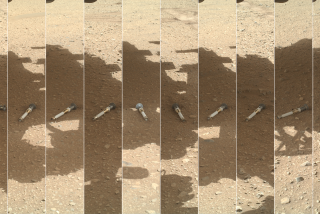THE CUTTING EDGE: COMPUTING / TECHNOLOGY / INNOVATION : Privatization Right Stuff for NASA?
- Share via
Remember the old parlor game of hiding a pea under one of three cups? The object of the game was to shuffle the cups around quickly so your opponent would lose track of which cup hid the pea.
In the end, the pea was still there, under the same cup, but if you were ambidextrous enough, your opponent might pick the wrong one.
I fear that may be what is happening with the nation’s space program. With all the talk of cutting costs, streamlining projects and turning the guts of the program over to private industry, the wizards in Washington are telling us we’re going to have a robust, safe program with a more reasonable price tag.
Maybe. But we’re still going to have just one pea, paid for entirely by the same people who are paying the bill now--the taxpayers. Industry is not going to pick up the tab, because commercial activities in space are still light-years away from being cost-effective.
As a senior scientist at one of the National Aeronautics and Space Administration’s research centers told me confidentially, the pea is still going to be under the same cup.
“It’s a tremendous amount of effort and change and restructuring and new management to continue doing what we were doing before,” he said. “But the money still comes from NASA. The mission is still there. It’s a tremendous stirring of the pot, and it’s all done in the name of downsizing government. But when you really come down to it, in the end it’s not clear to me that you’ve gained a lot after you’ve gone through it.”
No sane person would argue that the government does business as efficiently as a well-run private company. With all the bureaucratic structuring and layer upon layer of “oversight” committees, running a mammoth agency like NASA is a little like trying to steer an aircraft carrier with a canoe paddle. You need a lot of hands on the paddle, and the cost of that inefficiency is staggering.
Privatization, where practical, makes a lot of sense, but whether it will save billions of dollars remains to be seen.
Industry says it can do the job better and more cheaply. In the first step toward privatizing the space shuttle, NASA last week asked representatives from industry to submit proposals outlining their qualifications to take over the shuttle program.
The process could be completed within the next two to three years, and the winner will be, most likely, an expected joint bid from the two companies that seem to be the only qualified contenders--Rockwell Corp., which built the shuttles, and the newly merged Lockheed Martin Corp., which readies the shuttles for launch from the Kennedy Space Center in Florida.
All of NASA’s centers are headed toward some form of privatization, although not necessarily a full switch to industrial management. The model cited most often is Pasadena’s Jet Propulsion Laboratory, which is managed by Caltech. But whether that setup has reduced costs is debatable. JPL has had some of the nation’s most successful space projects, but the costs of major unmanned missions has soared past the billion-dollar mark, and JPL has gained the reputation of building gold-plated robots.
John M. Logsdon, director of the Space Policy Institute at George Washington University and one of the most knowledgeable space analysts in the country, thinks privatization is worth trying, especially for the space shuttle. “It’s certainly an experiment worth doing, because the shuttle costs too much.”
“The overhead of having NASA manage this is really substantial,” he adds. “There are multiple contracts rather than one consolidated contract, and there are multiple layers of civil service oversight. So I think a substantial savings comes in cutting down the number of people required to do this.”
In other words, fewer hands on the paddle might steer the old ship more cheaply. But the trick will be to do so without compromising safety.
“We’ve got to watch like a hawk” to protect against another Challenger disaster, Logsdon says.
What that will call for, of course, will be tight oversight by NASA. That means new committees and bureaucratic structures will almost certainly blossom so that the space agency can look over the contractor’s shoulder to make sure no safety shortcuts are taken. This is precisely the problem encountered by the national laboratories, including Lawrence Livermore and Los Alamos, that are managed by universities or private companies but closely supervised by the Department of Energy.
As industry tries to pry hands off the space program’s paddle, NASA will be trying to put others back on.
I suspect that what it will add up to is a space program that is somewhat better managed and a little more streamlined, but still very expensive. The politicians will point to the changes as evidence that they have made great progress in privatizing government programs.
But I fear that, like the street-corner sharpies who use the old parlor game to relieve the naive of their dollars, they will simply have switched the pea to a different cup.
*
Lee Dye can be reached via e-mail at [email protected].
More to Read
Inside the business of entertainment
The Wide Shot brings you news, analysis and insights on everything from streaming wars to production — and what it all means for the future.
You may occasionally receive promotional content from the Los Angeles Times.










